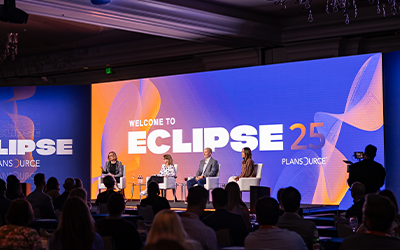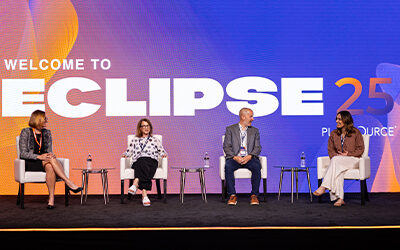Webinar Recap: 5 Workplace Trends to Weave into Your Employee Experience Strategy
Recently, we sat down with PlanSource’s Sharon Brand, Chief People Officer and Neil Mammele, SVP of Customer and Partner Development, to discuss which key 2023 trends should influence your employee experience strategy. Sharon provided valuable insight into the pressures HR leaders are feeling as well as ideas on how to respond while Neil discussed technology solutions he’s seen rise in popularity in recent months.
Short on time? Keep reading to find out which 5 trends we covered and what strategies you should consider as you prepare for open enrollment this year.
#1 Increased focus on affordable, preventative care
Many companies are currently spending upwards of $10,000-$15,000 per employee. How can you design a plan that is cost effective but also empowers employees to make the best decisions for themselves?
We’ve all been through a lot in the past few years and are still seeing lingering effects from the Covid19 pandemic arise. Since 2020, many employees had to delay preventative care and buckle down on medical spending. As a result, there’s been an increased number of late-stage diagnoses as employees play catch up regarding their health care. That means further increased costs for everyone involved.
As an employer, how can you get your employees focused on preventative care? Sharon mentions that one strategy PlanSource is shifting focus to providing more screenings, such as biometric screenings for preventative care. She goes on to mention that creativity with benefits and creating awareness are key aspects here. She is constantly thinking how a benefit can get into the hands of not only PlanSource’s employees, but their family and dependents too.
It’s also important to empower employees to make the right decision when they need it most – at open enrollment. With decision support technology, such as DecisionIQ, employees receive personalized insights and suggestions in their shopping experience. DecisionIQ also has the capability to help employees understand the right HSA/FSA contribution amounts and can complete localized cost comparisons for hyper-targeted cost estimates based on regional data.
#2 Reducing burnout and promoting well-being
Over the last two years, the lines have blurred between home, office, and work, with some people working around the clock. Employees need mental health support and additional resources to prevent burnout such as wellness days. Sharon mentions that 60% of employees say they are struggling with mental health issues and less than a quarter of those employees will actually seek treatment. This alone creates a huge opportunity to expand your offerings to make sure you’re investing in the right strategies and technology to have both short-term and long-term impacts.
It’s important to take a step back and assess what your population needs on an ongoing basis to make sure that those needs are incorporated in your plan. Accessibility of benefits comes into play here too. If the many benefits you offer aren’t easily accessible, utilization and engagement will remain low. Sharon also mentions the importance of leading by example. When your leaders respect their employees’ PTO requests and take adequate time off themselves, the rest of your workforce feels more encouraged to do the same.
#3 Outside forces are shifting employee lifestyle benefit preferences
Outside forces are more rapidly changing than they were in the past 10 years. Due to environmental factors, the impending recession, student loans and increased costs, it’s a race to keep tabs on what is going on politically, socially and within your industry. These factors often drive changes in employee benefit preferences, so it’s important to pay attention not only to what’s happening, but to how your workforce responds.
Between thousands of different benefit providers and evolving employee needs, it’s easy to see how HR leaders become quickly overwhelmed. How can you keep tabs on everything and ensure your benefits package is meeting employee needs? PlanSource tackles this with pulse surveys to get real feedback outside of analyzing benefit trends. Gathering feedback is only half the battle – you also have to respond appropriately.
PlanSource provides a wide variety of lifestyle benefits with our Partner Marketplace to help you navigate all of the providers in the market. With over 75 companies in our Partner Marketplace, it’s an easy centralized hub of pre-vetted point solutions, lifestyle, and voluntary benefits. The Marketplace includes benefits such as Pet Insurance, Identity Theft Protection, Virtual Primary Care/Telemedicine and more.
#4 Re-evaluating your hybrid work policies
The world went from an in-person work environment to a remote-first environment nearly overnight. Is it time to go back to how things were? Or is remote and hybrid work the new normal? If hybrid, how do we split our time to maximize productivity?
Sharon explains that the amount of time your employees need to spend in the office to be productive is not a magic number. It’s important to think about what works for your workforce and even what works for your employees on an individual level.
Many companies are now mandating employees return to the office, and not everyone is happy with this change. As you determine what’s right for your organization, remember to collect feedback and evaluate what is right for your culture and employee experience. A one size fits all solution probably won’t work for most. Think about your work environment policies the same way you do the rest of your benefits package and tailor it based on employee feedback.
#5 Empowering employees to take ownership of their benefits
Open enrollment is typically only two weeks – so what do employees do with their benefits the rest of the year after they’ve enrolled? Increased awareness around preventative care is important to reduce the number of high-risk diagnoses. At the end of the day, healthcare costs and high-risk diagnoses increase your benefit spend and affect your company’s bottom line. Communication can’t just start up a few weeks before OE, it must continue year-round to ensure continued education and improve utilization.
It all starts with planning. What ROI are you expecting? Are you getting the results you expect? Are your benefits accessible? If your employees enroll but haven’t been given the tools to use the benefits effectively, this can lead to a wasted investment.
Tips to keep in mind when designing your benefit package:
- Lean on your broker – Work with your broker to make changes and explore the market.
- Build strategies around the human experience – Take note of what your employees are doing and how they are feeling.
- Create open communication with carriers – Make it a priority to have year-round communication to always be in the loop.
- Evolve and enhance current offerings – Always be innovating and looking to improve your benefits package.
- Give employees a voice – Ask for feedback frequently and take action to incorporate their input.
- Create effective communication channels – Communicate with your employees year-round to ensure they know what is available to them.
Want to learn more?
Curious about what other advice Sharon and Neil shared? Watch the webinar on demand here or schedule a demo with one of our experts today.
Empathy, Innovation & Action: Top Takeaways from HR Leaders Who Spoke at Eclipse
Empathy, Innovation & Action:Top Takeaways from the HR Leaders Who Spoke at...
Charting the Future of PlanSource: Our Vision for What’s Ahead
Discover how PlanSource unveiled game-changing AI innovations at Eclipse 2025, transforming how HR leaders manage benefits and how employees choose them. The future of benefits starts here.
Navigating New Requirements with the Paperwork Burden Reduction Act
Navigating New Requirements with the Paperwork Burden Reduction...




